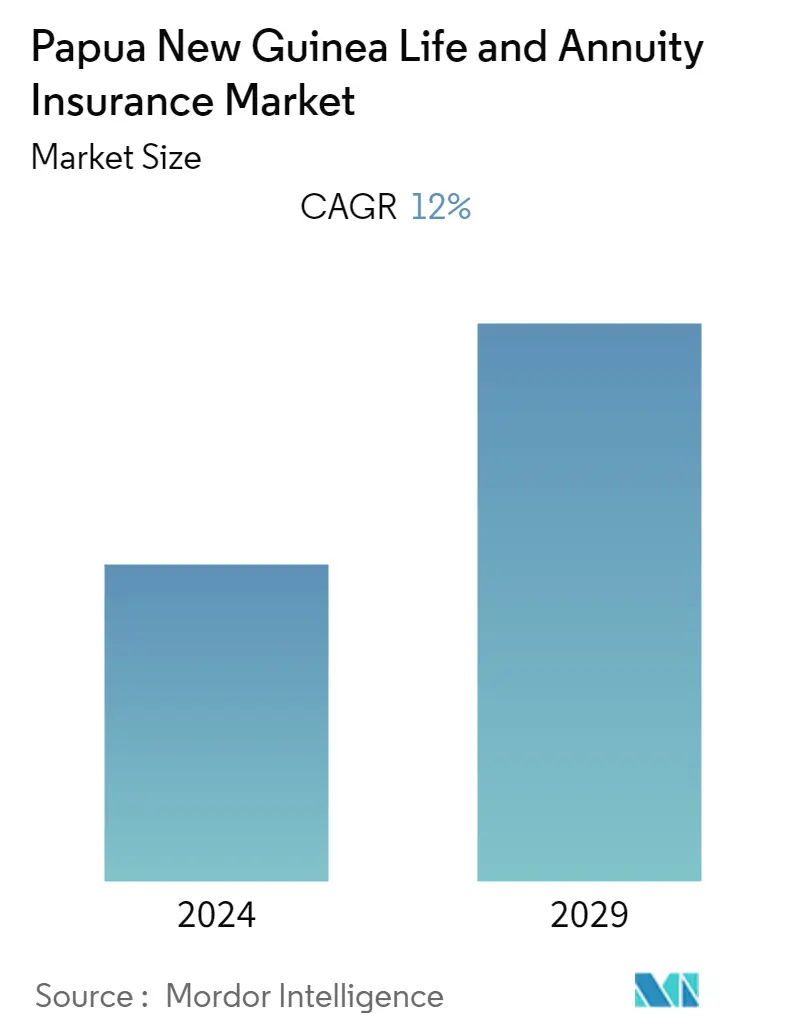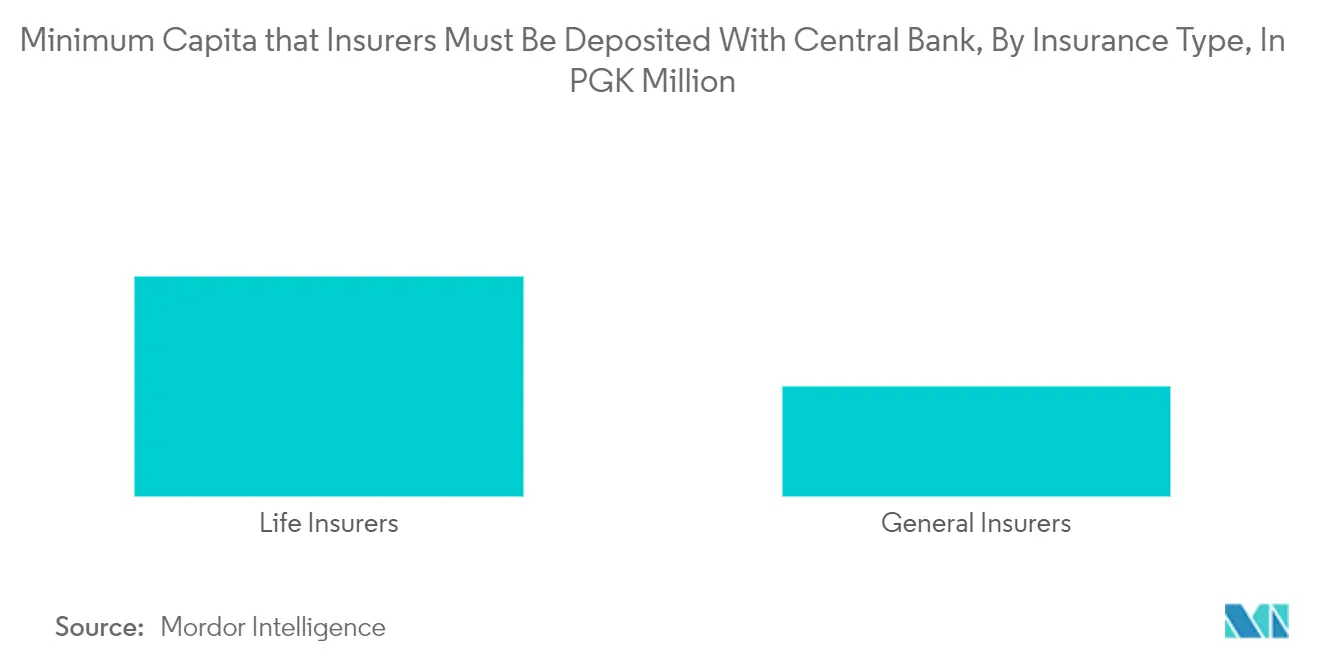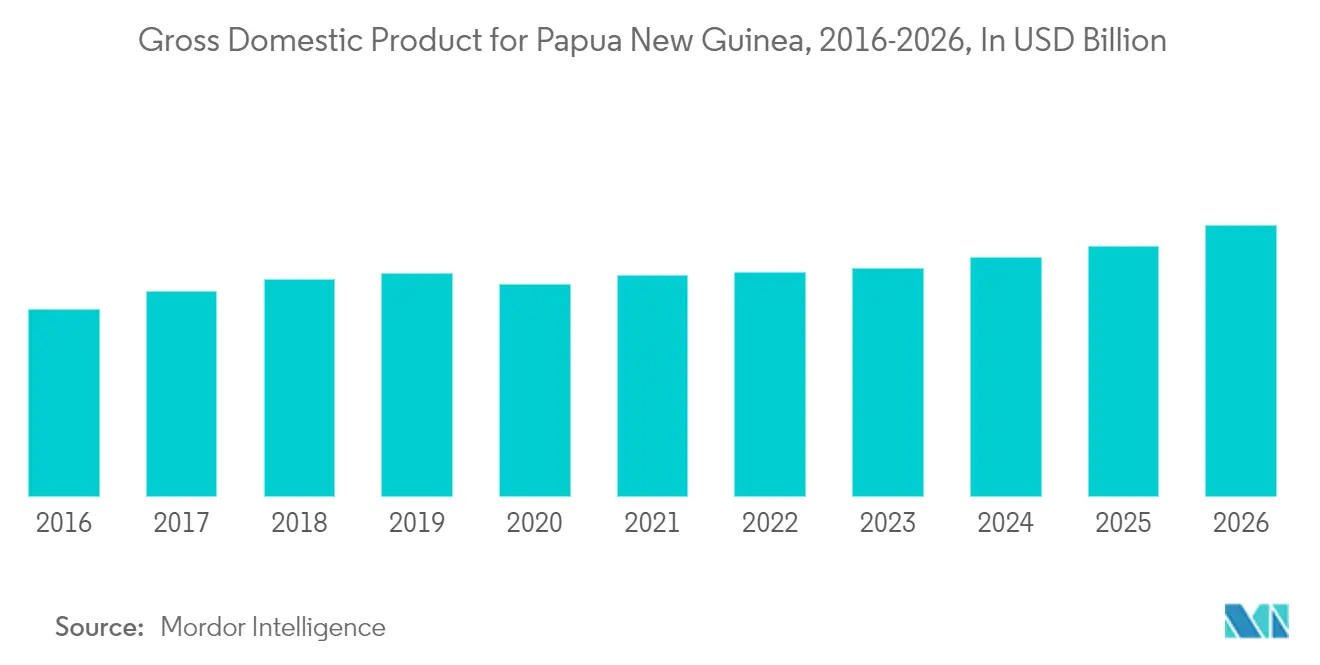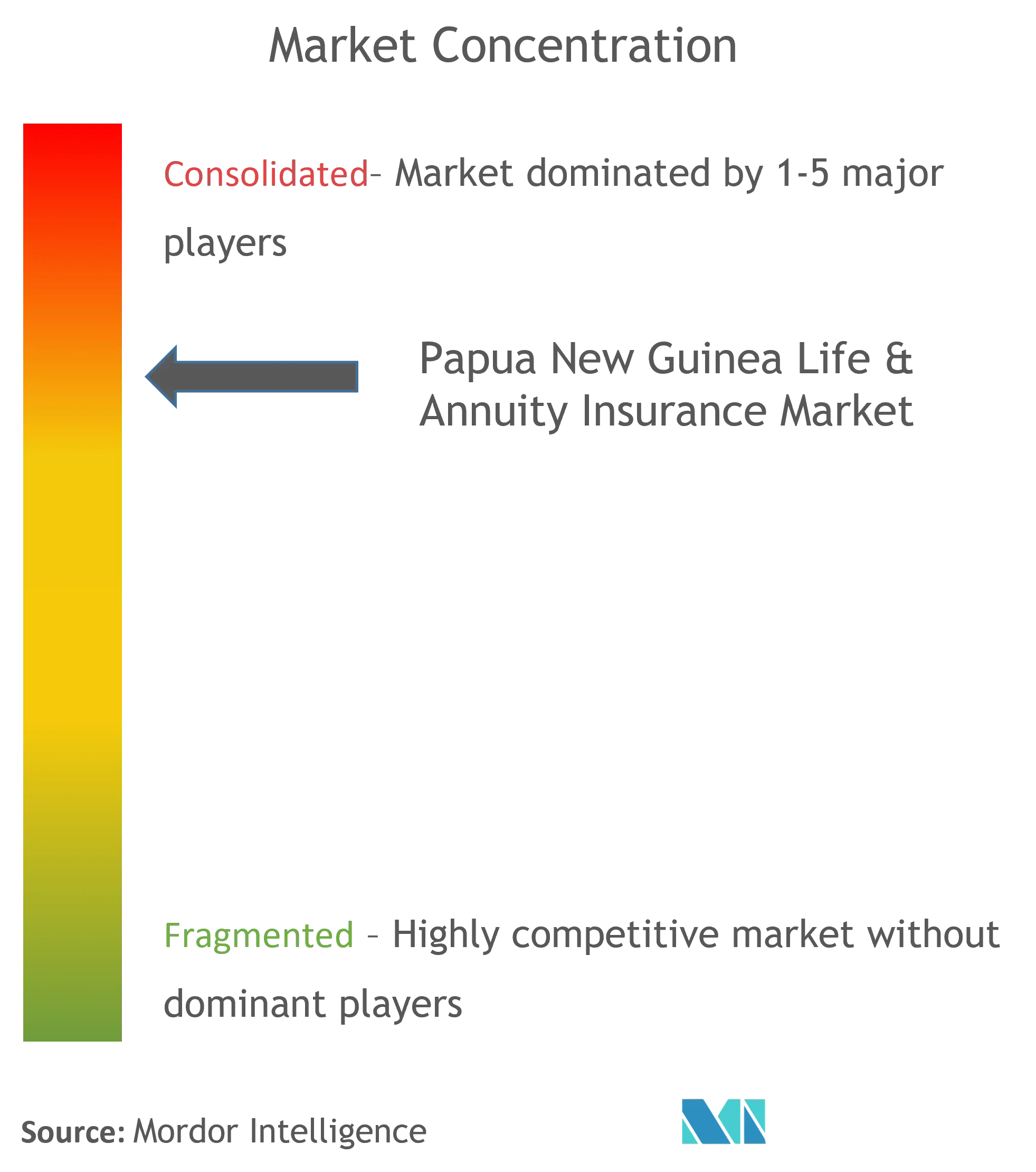Papua New Guinea Life & Annuity Insurance Market Size

| Study Period | 2020 - 2029 |
| Base Year For Estimation | 2023 |
| Forecast Data Period | 2024 - 2029 |
| Historical Data Period | 2020 - 2022 |
| CAGR | 12.00 % |
Major Players.webp)
*Disclaimer: Major Players sorted in no particular order |
Papua New Guinea Life & Annuity Insurance Market Analysis
Papua New Guinea Life & Annuity Insurance Market is estimated to record a CAGR of approximately 12% during the forecast period.
The pandemic effectively shuttered PNG for several months and reduced global demand for the commodities that drive its export earnings. As a result, the country's real GDP contracted in 2020, although a return to growth is expected in 2021. In response to the pandemic, the government launched a PGK 5.7 billion (USD 1.7billion) stimulus package, with a focus on supporting the health and security sectors, and workers and businesses. The outcome of this initiative and the government's wider efforts to protect citizens and the economy from Covid-19 will play a significant role in determining the future of the country's insurance market. The sector's future will also be contingent on the government's ability to continue important financial sector reforms, as well as the level of demand for mega-project risk-mitigation services and insurers' ability to pay out on pandemic-related claims.
In Papua New Guinea insurance makes up a small part of the overall economy when compared to international levels. The penetration rate as a percentage of GDP is under 2%, while the global average is 7.5%, according to the UN Development Programme. Insurance in the country is also a sector of great opportunity. Access is straightforward given the regulations and low capital requirements, so international participation is high and newcomers are relatively free to enter. In addition, because penetration is low, the market is well placed to grow.
On the ground, the sector is dynamic and quickly evolving. Banks are showing an interest in getting involved in the business, new and innovative products are being introduced, micro-insurance is booming, and local companies are seeking to further expand outside of the country. However, concerns remain. Competition is severe and some companies may be undercutting the market, leading to a lack of margins in some lines. Slower overall growth has meant slower premium growth, and economic troubles have the potential to weigh on the safety and soundness of the sector.
According to the most recent BPNG data, total financial industry assets reached PGK 51 billion (USD 15 billion) in September 2018. Of this total, superannuation funds and life insurance assets represented 25.8%, or PGK 13.2 billion (USD 3.9 billion). According to rating agency AM Best, gross written premium in the life insurance sector amounted to USD 15 million in 2019. At the end of 2019, BPNG reported that life insurance assets reached PGK 233.5 million (USD 68.9 million), up from PGK 198.7 million (USD 58.6 million) the previous year, marking an increase of 17.5%.
Papua New Guinea Life & Annuity Insurance Market Trends
This section covers the major market trends shaping the Papua New Guinea Life & Annuity Insurance Market according to our research experts:
Favorable Regulatory Reforms is Boosting the Market
The regulator of life insurance is the Bank of Papua New Guinea (Central Bank) which administers the Life Insurance Act 2000 and issues licenses to life insurance companies and brokers. In terms of Policyholder protection - Life insurance policyholders also have the benefit of the statutory fund relating to the life insurance business. The fund gives priority to the interest of the policyholders and has restrictions on its liabilities and expenditure. There is no restriction on what activities an insurer may outsource and no requirement for regulatory approval for outsourcing. However formal agreements with agents are required and may be monitored by the Insurance Commissioner. Responsibility for the outsourced service remains with the insurer.
The sector is open and welcomes foreign investment, and there are no specific foreign investment restrictions in place. However, certain steps must be taken for companies wishing to operate locally. They must be incorporated in the country (though some foreign insurers are grandfathered to operate as branches) and all insurance-related entities require authorisation to operate. This includes not only the insurance companies but also insurance agents, brokers and loss adjusters.
When an investor buys more than 15% of a life insurer, the investor must have the approval of the central bank as a shareholder controller. Standard fit-and-proper requirements are also in the relevant laws and must be met. However, the sector is not closed, and basic capital requirements are relatively low. The minimum capital for general insurers is PGK2million (USD 683,000), while it is PGK 4 million (USD 1.4 million) for life insurers.

An increase in Gross Domestic Product is driving the market
With a low penetration rate of below 2%, Papua New Guinea's insurance sector has significant growth potential. The economy is expected to benefit from a range of new extractive projects and this, coupled with growing awareness about the benefits of insurance coverage, is set to increase demand. However, some notable challenges will need to be addressed to ensure the long-term expansion of the industry.
While efforts have been undertaken to modernise the sector in recent years, the legislation governing the industry is not fully aligned with international best practices, and uncertainty remains regarding the division of responsibilities between different regulatory authorities. Despite a host of challenges, efforts to expand coverage across PNG to lower-income households are being made, with micro-insurance a key driver of penetration. While the majority of households lack sufficient income and financial literacy to take advantage of insurance coverage, the promise of a maturing economy bodes well for the sector over the long term.
As with financial services more broadly, the sector's performance has fluctuated in line with economic cycles. According to the first volume of the 2019 national budget, financial services and insurance sector activity is set to expand by 2.6% in 2019 compared to negative real growth of 2.3% in 2017. Driven by demand from new extractive projects, financial and insurance activity is expected to contribute around PGK 1.48 billion (USD 449 million) to real GDP in 2019 compared to PGK 1.44 billion (USD 437 million) in 2018.

Papua New Guinea Life & Annuity Insurance Industry Overview
The report covers major players operating in the Papua New Guinea life & annuity insurance market. The country has four life insurance companies and seven brokers. Insurance in PNG is in some ways well developed and highly competitive. The insurer provides a broad range of life and medical policies, including those targeting the self-employed and rural individuals. Insurance players in the market are Aon Risk Services, Marsh PNG, Kanda International Brokers & Risk Consultants, Niugini Islands Insurance Brokers, Capital Life Insurance, Pacific MMI, Kwila Insurance Corporation, Life Insurance Corporation, Workers Mutual Insurance Ltd and others.
Papua New Guinea Life & Annuity Insurance Market Leaders
-
Capital Life Insurance
-
Pacific MMI
-
Aon Risk Services
-
Marsh PNG
-
Kanda International Brokers & Risk Consultants
*Disclaimer: Major Players sorted in no particular order

Papua New Guinea Life & Annuity Insurance Market News
- January 2020 - BSP Life PNG, part of Bank South Pacific Group, launched Wantok Delite, an endowment product with policy terms of 15, 18, 21 or 24 years. Premium will be invested in various assets with an annual bonus indexed to the policy based on asset performance. The policy is aimed at job starters and small business owners, who can add policy benefits such as term-life protection, accidental death cover and permanent disability insurance. Wantok Delite complements BSP Life's existing consumer credit and group term-life insurance products. The latter aims to encourage companies to offer employees life cover.
- June 2019 - Despite recent efforts to increase insurance uptake, the market was heavily impacted by the exit of micro-insurance firm BIMA in mid-2019 after a wave of false claims were made, forcing the company to leave PNG. Previously, BIMA had offered family life and hospital cover through Capital Life Insurance, part of CIG, via mobile phone, in partnership with Jamaica-headquartered telecoms services provider Digicel.
Papua New Guinea Life & Annuity Insurance Market Report - Table of Contents
1. INTRODUCTION
- 1.1 Study Deliverables and Market Defination
- 1.2 Scope of the Study
2. RESEARCH METHODOLOGY
3. EXECUTIVE SUMMARY
4. MARKET INSIGHTS & DYNAMICS
- 4.1 Market Overview
- 4.2 Market Drivers
- 4.3 Market Restraints
-
4.4 Porters 5 Force Analysis
- 4.4.1 Threat of New Entrants
- 4.4.2 Bargaining Power of Buyers/Consumers
- 4.4.3 Bargaining Power of Suppliers
- 4.4.4 Threat of Substitute Products
- 4.4.5 Intensity of Competitive Rivalry
- 4.5 COVID-19 Impact on the Market
5. MARKET SEGMENTATION
-
5.1 By Insurance type
- 5.1.1 Individual Insurance
- 5.1.2 Annuity Insurance
- 5.1.3 Endowment Insurance
- 5.1.4 Juvenile Insurance
- 5.1.5 Whole Life Insurance
- 5.1.6 Medical Insurance
- 5.1.7 Others
6. COMPETITIVE LANDSCAPE
- 6.1 Vendor Market Share
-
6.2 Company Profiles
- 6.2.1 Capital Life Insurance Company Ltd
- 6.2.2 Kwila Insurance Corporation Ltd
- 6.2.3 Life Insurance Corporation (PNG) Ltd
- 6.2.4 Pacific MMI Insurance Ltd
- 6.2.5 Workers Mutual Insurance (PNG) Ltd
- 6.2.6 Asia Pacific Insurance Brokers Ltd
- 6.2.7 AON Risk Services Ltd
- 6.2.8 Marsh (PNG) Ltd
- 6.2.9 Niugini Islands Insurance Brokers
- 6.2.10 Kanda International Insurance Brokers & Risk Consultants Ltd*
- *List Not Exhaustive
7. INVESTMENT ANALYSIS
8. MARKET OPPORTUNITIES AND FUTURE TRENDS
9. DISCLAIMER
** Subject To AvailablityPapua New Guinea Life & Annuity Insurance Industry Segmentation
A complete background analysis of the Papua New Guinea Life and Annuity Insurance Market, which includes an assessment of the parental market, emerging trends by segments, significant changes in market dynamics and market overview, is covered in the report. The market is segmented by Insurance Type.
| By Insurance type | Individual Insurance |
| Annuity Insurance | |
| Endowment Insurance | |
| Juvenile Insurance | |
| Whole Life Insurance | |
| Medical Insurance | |
| Others |
Papua New Guinea Life & Annuity Insurance Market Research FAQs
What is the current Papua New Guinea Life & Annuity Insurance Market size?
The Papua New Guinea Life & Annuity Insurance Market is projected to register a CAGR of 12% during the forecast period (2024-2029)
Who are the key players in Papua New Guinea Life & Annuity Insurance Market?
Capital Life Insurance, Pacific MMI, Aon Risk Services, Marsh PNG and Kanda International Brokers & Risk Consultants are the major companies operating in the Papua New Guinea Life & Annuity Insurance Market.
What years does this Papua New Guinea Life & Annuity Insurance Market cover?
The report covers the Papua New Guinea Life & Annuity Insurance Market historical market size for years: 2020, 2021, 2022 and 2023. The report also forecasts the Papua New Guinea Life & Annuity Insurance Market size for years: 2024, 2025, 2026, 2027, 2028 and 2029.
Papua New Guinea Life & Annuity Insurance Industry Report
Statistics for the 2024 Papua New Guinea Life & Annuity Insurance market share, size and revenue growth rate, created by Mordor Intelligence™ Industry Reports. Papua New Guinea Life & Annuity Insurance analysis includes a market forecast outlook 2029 and historical overview. Get a sample of this industry analysis as a free report PDF download.



